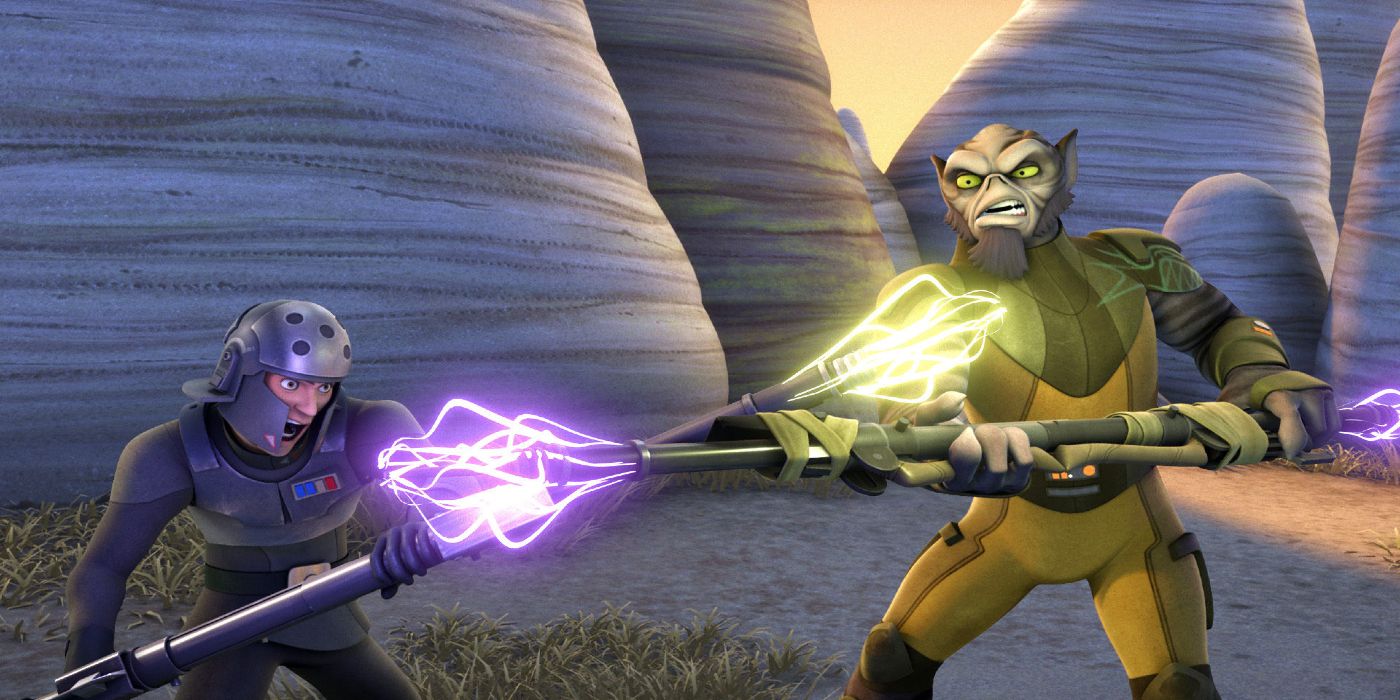
Swear words in Star Wars, like "dank farrik" in The Mandalorian, are rarely ever explained, but they serve an invaluable purpose in expressing characters’ emotions in a mostly family-friendly way. Star Wars has introduced more than 60 languages in the movies, television shows, and novels. But what is language without some colorful, albeit kid-approved vocabulary to match? Notable swear words like “dank farrik,” “kriffing,” “karabast,” and “e chu ta,” among others, make the Star Wars universe so rich and compelling.
Though most expletives in Star Wars borrow from real-life terminology, like "blast," "sod it," or "hell," they're most interesting when they don't sound like they're in Galactic Basic Standard. Original phrases like “dank farrik” may be in an alien language, but their intent isn’t difficult to translate. Swear words exist to convey resignation, fear, shock, anger, and dismay, emotions Star Wars characters experience on an ongoing basis. Judging by its appearances in The Mandalorian when characters face certain disaster, the meaning of “dank farrik” is quite apparent.
“Dank farrik” has become a permanent swear staple on The Mandalorian. It’s introduced by the as-of-yet unnamed Mythrol in the pilot episode after Din saves him from a ravinak and has since gained steam in season 2. Din says it during the showdown with the krayt dragon and later on when the Razor Crest malfunctions as it enters Trask’s atmosphere. Cara Dune mumbles it in episode 4 when the Mythrol has trouble opening the Imperial base door. The origins of “Dank farrik” are still unclear; however, seeing as it’s a prevalent swear word shared by characters traveling around the Outer Rim territories, it may very well stem from there. As a bounty hunter, it’s possible that Din picked up the curse from the criminals he's brought in. After all, many bad guys like the Hutts call the Outer Rim home, so it wouldn't be surprising if that's where it originated. Perhaps the creators also wanted to include a show-specific swear word that would forever be tied to Din and the team.

“Dank farrik” isn’t the first swear word in Star Wars lore. “Kriff” or “kriffing,” which is the galactic take on the f-word, was formerly featured in non-canon Star Wars Legends. It’s certainly made an impression, as it’s reappeared in several tie-in canon books like the Aftermath trilogy and Star Wars: The High Republic comic book series. “Karabast,” which is an exclamation of extreme irritation or surprise, is used most frequently by Rebel soldier and Lasat Zeb Orrelios in Star Wars Rebels. It also makes a brief appearance in Rogue One: A Star Wars Story by Commander Pao during the Battle of Scarif.
The Huttese language also has some of the filthiest and most creative curses in the galaxy. Phrases like “e chu ta,” what E-3PO says in response to C-3PO’s greeting in Cloud City in The Empire Strikes Back, doesn’t imply sociability. Rather, C-3PO is taken aback with a “How rude!” Since E-3POs were manufactured by the Galactic Empire, it’s not shocking that this particular droid would answer with such disdain. Other well-known insults in Huttese include “sleemo” or slimeball, “bantha poodoo” or bantha fodder. Apparently, banthas were known to eat some incredibly disgusting things, so “poodoo” by itself can easily be translated into any four-letter-swear for excrement.
Star Wars’ languages would not be as varied or realistic if they did not include some choice swear words. How else would characters communicate their feelings during space battles or planetary conflicts? The Mandalorian showrunners make this possible with “dank farrik,” which is now as intrinsic to that world as “kriff” is to the novels. It keeps the language relatively PG without sacrificing meaning.
from ScreenRant - Feed https://ift.tt/2Iqjle7

0 Comments